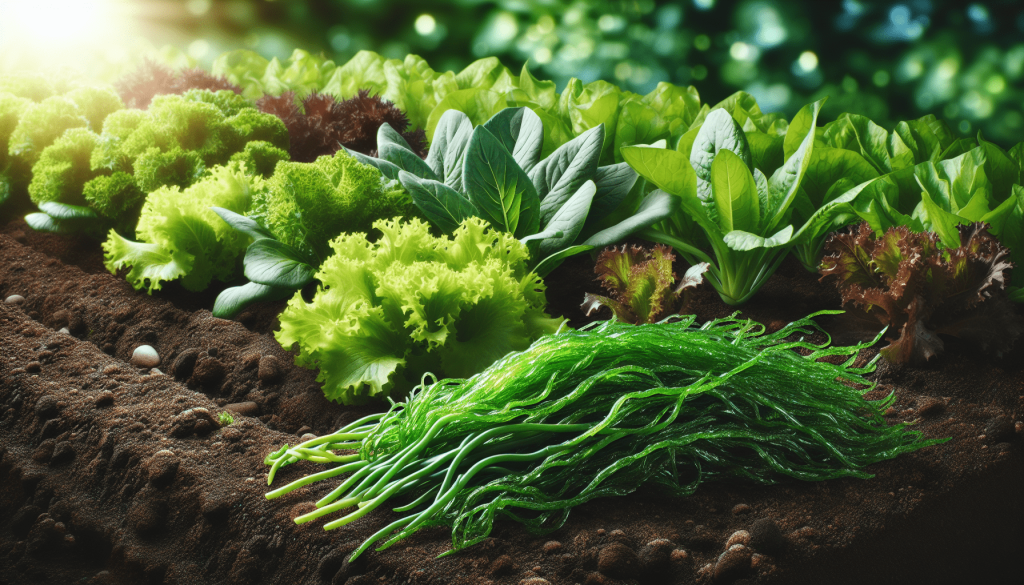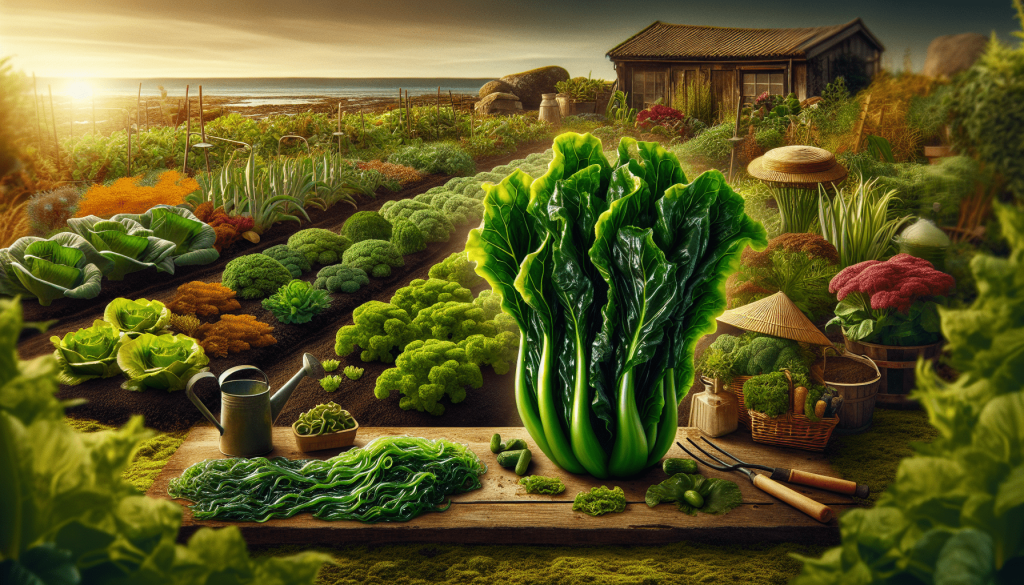This post may contain affiliate links. As an Amazon Associate, we may earn commissions from qualifying purchases.
Ever thought about improving your garden with something straight out of the ocean? You might picture seaweed in your sushi or floating by the seashore, but did you know it can be a powerhouse for your garden too?
A Glimpse Into Seaweed as Fertilizer
You might be curious about what makes seaweed a standout choice for garden enthusiasts. Well, it’s a question that pulls us into the marvels of marine life transforming your backyard into a verdant oasis.
Understanding Seaweed
Let’s start with the basics. Seaweed, the plant form growing in oceans worldwide, is plentiful and extremely rich in nutrients. There are various types – brown, green, and red – each teeming with different benefits for plant growth.
| Seaweed Type | Key Nutrients |
|---|---|
| Brown | Potassium, iodine |
| Green | Chlorophyll, magnesium |
| Red | Calcium, phosphorus |
Just imagine your plants soaking up these oceanic nutrients and growing robustly!
The Nutrient Treasure Trove
When asking what the benefits of using seaweed as a fertilizer are, we need to break it down to its basic components and how these impact your plants.
Potassium Power
Potassium is crucial for plants. It helps them manage drought, resist diseases, and grow stronger. Brown seaweed is particularly rich in potassium, making it an excellent booster.
Vital Vitamins and Minerals
If you’re looking for a vitamin supplement for your garden, seaweed is it. Packed with vitamins like A, B, C, and E, along with essential minerals, it’s like giving plants a nutritious salad.
Growth Hormones
Seaweed contains natural plant growth hormones like cytokinins, which encourage cell division and growth. This translates to faster germination, increased root growth, and overall improved vigor.

Soil Structure and Health
Healthy soil equals healthy plants, and seaweed contributes in more ways than one.
Soil Conditioning
Seaweed acts as a soil conditioner, improving its texture and water retention capabilities. Sandy soils become more cohesive, while clay soils become more permeable, fostering an optimal environment for roots to spread.
Microbial Activity
Seaweed stimulates microbial activity in the soil, creating a vibrant ecosystem. These microbes break down organic matter, making nutrients more accessible to your plants.
Environmental Benefits
Switching to seaweed as a fertilizer isn’t just good for your plants; it’s also environmentally friendly.
Sustainability
Seaweed is renewable and abundantly available, reducing the need for synthetic fertilizers, which are often fossil-fuel based. Harvesting seaweed is usually done sustainably, ensuring that marine environments are not disrupted.
Reduced Pollution
Using seaweed reduces the need for chemical fertilizers, which can pollute water bodies through runoff. By opting for seaweed, you’re helping to keep your local waterways cleaner and healthier.

Application Techniques
You’ve got the what and the why; now let’s get into the how. Applying seaweed to your garden can be done in several ways, and each method offers unique benefits.
Seaweed Extracts
Liquid seaweed extracts are one of the most common forms. You can spray them directly onto the leaves or add them to your watering can. This method allows for quick nutrient absorption.
Seaweed Mulch
If you’ve got access to fresh seaweed, you can lay it out as mulch. Washing it first is a good idea to remove excess salt. As it decomposes, it releases its nutrients gradually, enriching the soil.
Seaweed Compost
Adding seaweed to your compost pile is another way to go. It breaks down along with other organic matter, injecting a potent nutrient blend into your compost mix.
Tailored Benefits for Different Plants
Different plants have different needs, and seaweed can be tailored to fit.
Vegetable Gardens
Vegetables like tomatoes, peppers, and cucumbers thrive with a little seaweed love. The extra potassium and growth hormones can result in more robust plants and higher yields.
Flowering Plants
Flowers benefit from seaweed too. Roses, for example, will shine with more vibrant blooms when given a seaweed boost. The vitamins and minerals enhance color and longevity.
Lawns
Even your lawn can get greener with seaweed. Regular applications can improve root health, making your grass lush and resilient.
Common Misconceptions
Smell Factor
One fear is that using seaweed might give your garden an unpleasant oceanic smell. Fresh seaweed might be a bit pungent, but rinsing and proper application generally eliminate this concern.
Salt Content
Worried about the salt? Most seaweeds have a low salt content after a good rinse, and any residual salt is unlikely to harm plants. In fact, small amounts can be beneficial, aiding in nutrient uptake.
The Science Behind the Magic
Cytokinins and Growth
Delve into the nitty-gritty of what makes seaweed work wonders. Cytokinins not only speed up growth but also enhance photosynthesis and delay the aging of leaves, giving plants a longer productive life.
Alginates for Soil
Alginates in seaweed help soil particles bind together, improving structure and making it easier for roots to penetrate. This is particularly beneficial for poor soils needing a little extra care.
Amino Acids
These building blocks of life are abundant in seaweed. They aid in various plant processes, from chlorophyll production to stress resistance. By supplementing your soil with amino acids, you’re ensuring your plants have what they need to thrive.
Personal Experiences and Stories
Imagine a garden where plants burst into flower with vibrant colors, all thanks to that green gold from the sea. Jane from Maine swears by her seaweed fertilizer for her roses. Every year, she gathers seaweed from the local shoreline, gives it a good rinse, and adds it to her compost. Her roses? They practically glow.
Then there’s Tom, who’s turned his vegetable patch into a treasure trove of productivity with liquid seaweed extracts. His secret sauce has upped his tomato game, making them juicier and more flavorful.
Practical Tips
Harvesting Your Own
If you live near the coast, harvesting your own seaweed can be a rewarding endeavor. Just check local regulations to ensure you’re collecting sustainably. Rinse it well to remove any salt and debris.
Store-Bought Options
For those inland, various commercial seaweed fertilizers are available. They come in powder, liquid, or pellet form, giving you flexibility in how you apply them.
| Type | How to Use | Best For |
|---|---|---|
| Liquid Extract | Spray or water onto plants | Fast absorption, foliar feeding |
| Powdered | Mix into soil or compost | Long-term nutrient release |
| Pellets | Spread on soil surface | Easy application, gradual feed |
Conclusion
Seaweed stands out as a multitasking marvel for your gardening needs. It’s rich in essential nutrients, environmentally friendly, and versatile in application. Whether you opt for store-bought or harvested from your local beach, it’s worth inviting this oceanic treasure into your garden.
So, next time you’re by the seashore, you might look at seaweed differently, envisioning the lush, thriving garden it could help you cultivate. From healthier soil to more vibrant plants, seaweed offers a bounty of benefits just waiting to be discovered. Your garden, and the environment, will thank you.








